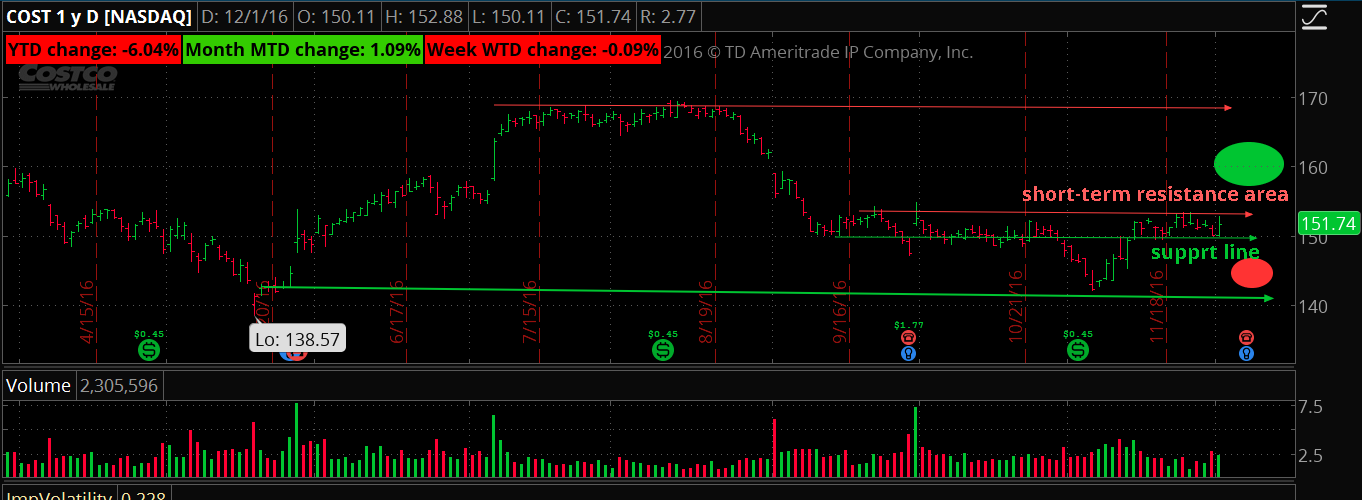Costco Wholesale Corporation (NASDAQ:COST)
Costco Corporation, the largest membership-only warehouse club in the United States and the second largest retailer in the world after Walmart (NYSE:WMT), will report their quarterly earnings on December 7th, after the market closes. The company has 705 warehouses spread throughout the United States, Canada Mexico, United Kingdom, Japan, South Korea, Taiwan, Australia, Spain and Lebanon.
Costco didn’t originally start out as Costco. In fact, it came from what’s called ”Price Club”, started by a gentleman named Sol Price and his son Robert. They opened their first warehouse in 1976 in San Diego, California. The two companies merged and became Costco in 1993.
The current environment for retail has been difficult, with some retailers experiencing heavier foot traffic than normal and other retailers reporting less. The last time Costco reported, they were showing signs of improvement, especially on their bottom-line profits. Costco gets most of their profits from membership fees, rather than sales of their products. Therefore, subscriber additions and subtractions are critical for their business model. Recently, Costco changed their credit card of choice from American Express to Discover Card. This quarterly earnings results will likely shed light on how that is working out for the company.
Costco Wholesale Chart

In the above price chart for Costco, please see the upper red resistance line and the lower green support line. Those are where the longer-term areas of support and resistance lie. The shorter-term support and resistance areas are the inside trend lines. You will note two oval shaded areas one green and one red. These areas are likely where Costco will trade after they report earnings on December 7th. However, only one of these shaded areas is where price will likely find itself.
Some Industry Secrets Revealed By Sector Industry Insiders
In a broad sense, warehouse clubs mark up their items less than traditional grocery stores or retailers, Michael Clayman, editor/writer at Warehouse Club Focus and www.warehouseclubfocus.com (account required) told The Motley Fool in an email interview.
Generally, club merchandise gross margins will range from an average of 12% to 14% with Costco and Sam’s Club at the low end of the range and BJ’s at the higher end of the range.
That compares to 25%-50% margins for traditional stores.
Every year, we publish an item basket comparison between the three clubs, a Wal-Mart Supercenter, and a grocery store in the same market...The results have been consistent and show the dramatic savings a consumer receives by shopping at a club compared to the other two.
Taken as a whole and over a span of years, the answer is that warehouse clubs almost never save money for the individual shopper... (due to) membership fees, wastage from overbuying (produce and such), the necessity to buy in quantity (canned goods that sit on shelves and have to be discarded) etc.
Benjamin Glaser, an editor for DealNews, a shopping comparison website, agrees with the idea that warehouse clubs can be a trap. He told The Motley Fool in an email that chains like Costco, Sam’s Club, and BJ’s,
can save you money, but they can also trick you into spending more.
He noted that low-priced items are actually one of the bigger reasons members end up spending more than they would have had they not joined.
Great prices are why you walk in to buy milk, and walk out with a big-screen TV
Company Profile
Costco Wholesale Corporation is engaged in the operation of membership warehouses in the United States and Puerto Rico, Canada, the United Kingdom, Mexico, Japan, Australia, Spain, and through its subsidiaries in Taiwan and Korea. As of August 28, 2016, the company operated 715 warehouses across the world. The company’s average warehouse space is approximately 144,000 square feet. The company’s warehouses, on average, operate on a seven-day, 70-hour week.
The company offers merchandise in various categories, which include foods (including dry foods, packaged foods and groceries); sundries (including snack foods, candy, alcoholic and nonalcoholic beverages, and cleaning supplies); hardlines (including appliances, electronics, health and beauty aids, hardware, and garden and patio); fresh foods (including meat, produce, deli and bakery); softlines (including apparel and small appliances), and other (including gas stations and pharmacy).
